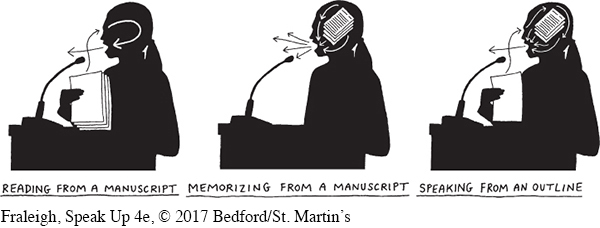Reading From a Manuscript
In this delivery mode, you give your speech by reading directly from a script—a typed or handwritten document containing the entire text of your speech. As you read, you typically do not deviate from your script or improvise.
Although most people using this delivery mode read from a printed script, it has become increasingly popular for speakers to use teleprompter devices when addressing large audiences. From the audience’s perspective, teleprompters are clear, appearing as small glass screens around the speaker; from the speaker’s perspective, however, they display lines of text, which advance in time with the speech. Having more than one teleprompter allows the speaker to appear to shift his or her gaze toward different parts of the audience while continuing to read the text from the prompter. Although teleprompters might seem ubiquitous—
Delivery from a script is appropriate in circumstances in which speakers (or speechwriters) need to choose their words very carefully. The word-

370
Still, reading from a script has its disadvantages. To begin with, the script itself becomes a prop—

In addition, when you read from a script, you tend to speak in a monotone rather than a conversational tone. Some listeners will find this mode dull and impersonal, while others may even consider it condescending. Consider the words of one student about a fellow classmate: “To tell you the truth, I almost found it insulting. If all [the speaker] wanted to do was read to us, he could have just given us the notes and let us read them ourselves.”